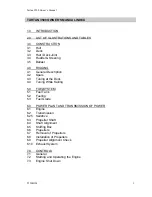
7
Mast Float Usage & Fitment Recommendations
The greater the volume of the mast float used,
the higher the inversion resistance it will provide.
9 LITRE
INFLATABLE MAST FLOAT
(Heavy duty fabric construction)
Part Code # 90718
The single eyelet at the top of the float
should be tied directly to the sails mast
head cap webbing using a short piece of
4mm diameter rope.
A second piece of the same rope should
then used to tie a small bow- line loop
which passes through both the eyelets
at the bottom of the float.
The resulting rope tail should then be
passed down the front face of the mast
before being tensioned and cleated
or tied to the bridge piece of one of
the clam cleats in the region of the
gooseneck.
40 LITRE
INFLATABLE MAST FLOAT
(Heavy duty fabric construction)
Part Code # 90720
With the mainsail ready to hoist:
Form a short loop in the end of the
halyard and pass the loop through the
eye in the head of the mainsail.
Pass the loop through the stainless “D”
ring on the end of the mast float.
Pass the bobble (on the very end of the
halyard) through the aforementioned
emerging loop and pull the body of the
halyard backwards firmly to secure.
Hoist the mainsail to the desired height
before cleating. (You may be reefed).
Note: This mast float only supports
attachment at one end so fitment
parallel to the mast is not possible.
15 LITRE
MAST FLOAT
(Heavy Duty Rotor Moulded
Construction)
Part Code # 90530
Apply the self adhesive neoprene strip
to the top of the mast. This should
be butted up to the top edge of the
aluminium and not onto the mast head
fitting.
Place the mast head float onto the mast
head with the narrow end to the front of
the mast. Thread the rope through the
lacing eye on the front of the mast head
float and the front of the mast.
Securely tie the mast head float onto
the mast.







































